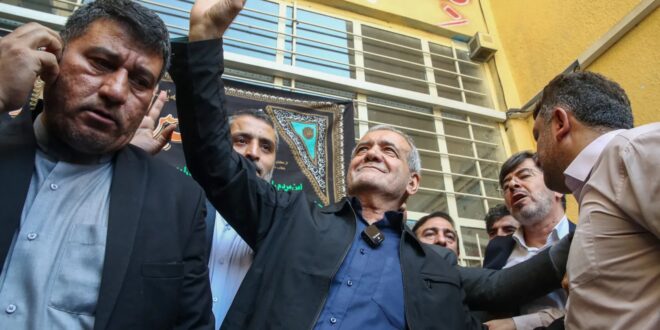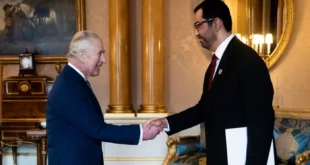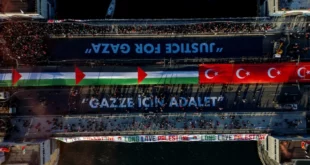Masoud Pezeshkian Will Not Cross the Supreme Leader
On July 5, the parliamentarian Masoud Pezeshkian prevailed in Iran’s snap presidential election. It was a surprising win. Pezeshkian is a relative moderate who pledged to engage with the West, end Internet filtering, and cease the morality police’s harassment of women—a program not endorsed by the country’s clerical elite. Instead, Iranian Supreme Leader Ali Khamenei wanted a president in the mold of Pezeshkian’s hard-line predecessor, Ebrahim Raisi, who died in a May helicopter accident. As a result, most experts believed that Khamenei would maneuver to ensure the election of another proven conservative. As I wrote in Foreign Affairs shortly after the helicopter crash, “Iran’s next president will almost certainly be just like its last.”
But although Pezeshkian may hold different views from Raisi, in practice, his government may operate much like his predecessor’s. Iran’s new president, like its last, is devoted to the Islamic Republic’s structure and identity. During his campaign, he did not promise sweeping shifts: long gone are the days when Iranian presidential candidates proposed lofty visions for promoting democracy, civil society, human rights, and rapprochement with the United States. Instead, Pezeshkian worked to prove that he was the candidate most capable of executing policies set by Khamenei. He pledged fealty, again and again, to the supreme leader. He rejected the reformist-conservative dichotomy, stating that he did not belong to any political camp. Perhaps that is why, although the election featured candidates with supposedly different views, voter turnout was historically low. Only 40 percent of people participated in the first round, and just 49 percent turned out for the second. In the 1997 election, by contrast, the reformist won 70 percent of the ballots in an election in which 80 percent of eligible Iranians voted.
Pezeshkian’s win will lead to some policy shifts. His government, for example, might strike a modest nuclear deal with Washington. It could also create some social and political space for its citizens, particularly for young people and women. If realized, his measures will alleviate the hardship of Iranians’ daily lives and foster a sense of hope and optimism.
But on the whole, Pezeshkian is likely to govern in seamless coordination with the supreme leader—just as Raisi did. The country will maintain its assertive regional policies and nuclear program. It will strengthen its friendships with China and Russia, and it will continue to thaw ties with neighboring countries. It will ensure the Islamic Revolutionary Guard Corps (IRGC) maintains its economic and political autonomy, allowing it to continue its corrupt behavior and to keep repressing dissidents. Iran may have a surprising new president, but the future of Iran still looks like its past.
COME FROM BEHIND
When Pezeshkian announced he was running for president, his candidacy was not taken especially seriously. A cardiac surgeon and war veteran of the Iran-Iraq War of the 1980s, Pezeshkian was disqualified from the 2021 presidential election for his reformist views. He was initially disqualified from the 2024 parliamentary elections, as well, for criticizing the morality police when Mahsa Amini—a 22-year-old Iranian woman—died in their custody after being arrested for not wearing her headscarf properly. Pezeshkian was reinstated in the parliamentary elections only after Khamenei personally intervened. And Pezeshkian did not make much of a name for himself after winning; in the 2024 presidential elections, he was one of the three candidates on the reformist list. He became the camp’s standard bearer not by choice, but by default, as the only reformist the supreme leader let compete (likely in a bid to increase turnout).
But as the race got underway, Pezeshkian proved to be quite savvy. He had former reformist presidents Mohammad Khatami and Hassan Rouhani campaign aggressively on his behalf. He brought on Javad Zarif, Rouhani’s capable foreign minister, to help run his team. He gained popularity among more-liberal voters by promising to halt Iran’s economic slide and to push back against social restrictions. But he also cultivated former Raisi supporters by making constant references to the Koran and other religious texts. He emphasized the president’s limited role as executor of the supreme leader’s policies. And his concentration on social justice appealed to the country’s poor and working classes. He thus put together a coalition of reformers and moderate conservatives that helped him place first in the election’s opening round, with 42 percent of the vote.
In the runoffs, Pezeshkian faced an extreme hard-liner, Saeed Jalili. The former secretary of Iran’s Supreme National Security Council, Jalili has argued that making women wear veils is a matter of national security, describing headscarves as the Islamic Republic’s “strategic depth.” His ultraconservative supporters in parliament have spearheaded what their opponents term a “purification project,” aimed at purging elites who diverge from their ideological views. These stances made him look radical even when compared with other conservative leaders.
Pezeshkian took full advantage. His team declared that Jalili would restrict social freedoms and exacerbate women’s challenges (particularly concerning dress codes). But to win over more conservatives, reformists also accused Jalili’s far-right backer—the powerful Front of Islamic Revolution Stability—of planning to challenge both Khamenei’s authority and that of the IRGC. Zarif even claimed that General Qasem Soleimani, the IRGC commander assassinated by the United States in 2020, was so critical of Jalili’s hard-line views that he once said he would resign if Jalili became president.
These tactics worked. Reformist leaders continued to promote Pezeshkian. Many senior conservative figures, including some of Khamenei’s confidants and advisers, also backed him. In the end, he defeated Jalili by nine percentage points.
THE MORE THINGS CHANGE
As president, Pezeshkian is likely to enact some new policies. He will probably reduce Internet censorship, allowing millions of people to access websites without using expensive antifiltering software. He will pursue initiatives to improve health care and educational access for the poor. He will create at least a somewhat less restrictive environment for the press, women, and ordinary Iranians—as long as their activities do not pose a threat to the system. And if he succeeds at creating a more efficient bureaucracy, enacted with the help of what is likely to be a younger and more diverse cabinet, reformists may be able to win back their old constituencies: Iran’s youth, women, and middle class.
But the current balance of power in Tehran will prevent Pezeshkian from making deeper changes. The conservative establishment, led by Khamenei, controls all the country’s power centers, including the security apparatus, the judiciary, the media, and much of the economy. Even if Pezeshkian were not so restricted, it is unlikely he would fight for sweeping shifts. The incoming president may not be as subservient to Khamenei as Raisi was, but Pezeshkian is unlikely to challenge the supreme leader as much as Khatami and Rouhani did. In addition to pledging total loyalty to Khamenei, Pezeshkian spent his campaign stressing that the next government’s task “is not to set new plans or announce new policies.” According to the country’s Mehr News agency, on his first day as president-elect, Pezeshkian canceled a planned press conference to instead meet with Khamenei. In his first speech after the election, he thanked the supreme leader for safeguarding the integrity of the voting process. “Without him,” Pezeshkian said, “I do not imagine my name would have easily come out of these [ballot] boxes.”
Domestically, this fealty means Pezeshkian is unlikely to tackle the formidable challenges facing Iran’s economy. His experienced economic team might bring some order to the country’s financial system and lower the inflation rate, but the entities that have strangleholds on the country’s economic ecosystems are largely controlled by the supreme leader and the IRGC. And Pezeshkian will not challenge either. Both entities also control the country’s social ecosystem, and they appear committed to maintaining the status quo. The government, for example, arrested Mohsen Borhani—a prominent lawyer critical of crackdowns on people protesting Amini’s death—just one day after Pezeshkian’s election.
Pezeshkian’s deference to the supreme leader and the IRGC also means Iran will retain strong ties to its so-called axis of resistance, a network of allied nonstate actors featuring Hamas, Hezbollah, the Houthis, and Iraqi Shiite militias. The axis is the crown jewel of the Islamic Republic’s defense strategy, thanks to its regional influence and ability to disrupt economic chokepoints such as the Strait of Bab el Mandeb. Whereas past reformist presidents clashed with the IRGC over its handling of the network, Pezeshkian, like Raisi, will cooperate with it. In fact, he has already sent strong shows of commitment to axis organizations. In a message to Hezbollah leader Sheikh Hassan Nasrallah, Pezeshkian emphasized Iran’s support for “the resistance of the people of the region against the illegitimate Zionist regime,” one “rooted in the fundamental policies of the Islamic Republic.” Similarly, in a letter to Hamas chief Ismail Haniyeh, Pezeshkian promised that the Islamic Republic “will continue to support the oppressed Palestinian nation until the realization of all its ideals and rights.” Pezeshkian will also build on Raisi’s efforts toward reconciliation with Saudi Arabia and other neighboring states. As he wrote in an opinion piece published in the Qatar-based Al-Araby Al-Jadeed, “The top priority of Iran’s foreign policy is to expand cooperation with its neighbors.”
GET REAL
Throughout Raisi’s tenure, reformists criticized his “eastward-looking” foreign policy, which focused on building strong relationships with China and Russia while confronting the West. Instead, they advocated for a more balanced approach. But Khamenei and the IRGC supported Raisi’s strategy, and they appear set on making sure it continues. Not long after Raisi died and shortly before the second round of the election, acting Iranian President Mohammad Mokhber held a televised meeting with Russian President Vladimir Putin in which he said Khamenei appreciated the “deep and unchangeable” relations between the two countries. Mokhber also asserted their ties “will not change with the change of administrations.” Similarly, Mokhber met with Chinese President Xi Jinping and affirmed Tehran’s commitment to strengthening relations with Beijing.
Here, however, Pezeshkian may gradually attempt a bigger break from his predecessor. During his campaign, Pezeshkian showcased his foreign policy stance by appearing on television, seated with Zarif to his right and Mehdi Sanaei to his left. This symbolic positioning underscored his commitment to a balanced East-West policy. Zarif studied in the United States and is Iran’s former UN ambassador, and Sanaei is Iran’s former ambassador to Russia. Pezeshkian declared that, without U.S. sanctions relief, Iran will be economically constrained. His national security team will feature many of the same players that negotiated the Joint Comprehensive Plan of Action. And in another op-ed piece, this one published in the English-language Tehran Times, Pezeshkian made a vague and cautious overture to Iran’s adversaries, including, perhaps, Washington. “We will welcome sincere efforts to alleviate tensions and will reciprocate good-faith with good-faith,” he wrote. It echoed former U.S. President George H. W. Bush’s famous line to Iran—“goodwill begets goodwill”—during his inaugural speech in 1989.
Khamenei views overtures to Washington skeptically, arguing that talks with the United States do nothing but antagonize China and Russia. But the new president’s allies still think they have the latitude to succeed. During the campaign, Zarif said that although the supreme leader makes foreign policy decisions, the president’s team can influence the debate through the policy options it presents—a theory that Pezeshkian could test in talks with the United States. The results would give analysts a sense of just how much power Pezeshkian has.
Even with Pezeshkian’s win, Iranian moderates remain weak.
Yet even if Khamenei gives Pezeshkian a relatively long leash, his government is unlikely to negotiate another ambitious nuclear agreement. It will, instead, look to ink a deal that could freeze or incrementally scale back Iran’s nuclear advances, including by reducing the quality and quantity of the uranium Iran enriches, in exchange for sanctions relief. Such a transactional deal would have multiple advantages for Pezeshkian. Given Khamenei’s support, Iran’s conservatives would be less likely to sabotage that deal than they were the 2015 agreement. And it would be easy for Tehran to ramp up its program if the United States withdraws again, as occurred under President Donald Trump in 2018.
Washington should make a good-faith effort to craft such an agreement, which would add some stability to a turbulent region. The United States should also maintain open channels to Tehran, especially if Pezeshkian makes communicating easier. But U.S. officials and commentators should not get overly optimistic about Pezeshkian’s presidency. They should avoid framing any negotiations with Iran’s new administration as the beginning of a diplomatic breakthrough. They should certainly avoid saying that the United States is trying to strengthen Iran’s moderates vis-à-vis its hard-right elites. Such a claim could incite fear within Iran’s conservatives that Washington is attempting to instigate a revolution, making them more bullish and aggressive. In other words, it risks further empowering the very actors U.S. officials want to weaken.
It would also be pointless: even with Pezeshkian’s win, the country’s moderates remain weak, and they currently lack the capacity to challenge the supreme leader. They carry little weight within his institutions, including the IRGC. They do not have support from most of Iran’s citizens. Previously, reformists viewed elections as a way to empower moderate presidents to balance the supreme leader. But as Pezeshkian’s statements show, they have accepted that Khamenei’s authority really is absolute. Now, they are simply looking to do the best they can within the constraints he has given.
 Eurasia Press & News
Eurasia Press & News



